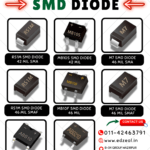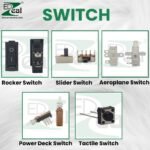Understanding Diodes: Types, Functions & Real-World Uses

What is a Diode? – Working, Types & Applications

Introduction
Diodes are among the most widely used components in electronics. They act like one-way valves for current, enabling rectification, voltage regulation, protection from transients, signal detection, and even light emission. Whether you’re building a charger, an inverter, or a microcontroller-based product, understanding diodes helps you design safer, more efficient circuits.
Definition: What Is a Diode?
A diode is a two-terminal semiconductor device formed by joining P-type and N-type materials to create a PN junction. Current flows readily from the anode to the cathode in forward bias, and is blocked in reverse bias. This directional control of current is the basis for rectifiers, reverse-polarity protection, and more.
How a Diode Works
In forward bias, the junction barrier lowers and charge carriers cross the PN junction—so current flows. In reverse bias, the barrier increases and the diode resists current, up to its rated reverse voltage. Exceeding that limit can cause breakdown (sometimes intentionally used in Zener diodes for regulation).
Quick tip: Always add headroom—select reverse voltage ratings at least 20–30% above your worst-case operating and transient levels.
Main Types of Diodes & Where They Fit
Rectifier Diode
Converts AC to DC in power supplies. Look at VRRM (reverse voltage), IF (forward current), surge current (IFSM), and thermal limits.
Zener Diode
Regulates voltage by conducting in reverse at a defined breakdown level (VZ). Common for references and simple clamps on low-power rails.
Schottky Diode
Very low forward drop and fast switching. Ideal for DC-DC outputs, OR-ing, and freewheel paths. Watch leakage at higher temperatures.
TVS / ESD Diode
Absorbs fast transients (ESD, EFT, surge). Choose clamping voltage below your IC’s absolute max and verify IEC ESD ratings.
LED (Light-Emitting Diode)
Emits light with a forward current. Consider wavelength, luminous intensity, and proper current limiting plus thermal path.
Photodiode
Generates current from light for sensing and optical links. Check responsivity, dark current, and bandwidth.
Selection Checklist (For Real Projects)
| Parameter | Why It Matters | What to Aim For |
|---|---|---|
| Reverse Voltage (VR / VRRM) | Survives line spikes and inductive kickback | ≥ 20–30% above worst-case reverse stress |
| Forward Current (IF) | Handles load current without overheating | Derate for ambient, enclosure, and duty cycle |
| Forward Drop (VF) | Affects efficiency & heat, critical at low voltages | Prefer Schottky for efficiency; validate at temp |
| Switching Speed / QRR | Impacts SMPS efficiency and EMI | Use fast/ultrafast or Schottky at high frequency |
| Thermal Resistance (RθJA/RθJC) | Determines junction temperature rise | Provide copper area, vias, or heatsinking |
| Package / Footprint | Assembly yield and line changeovers | Standardize SMD (SMA/SMAF/SMB, SOD-123/323, SOT-23) |
Everyday Applications
- Chargers & Power Supplies: Bridge rectifiers, freewheel paths, output.
- Protection: Zener or TVS clamps on MCU pins, buttons, data lines.
- Lighting: LEDs for indicators and illumination with proper drivers.
- Energy: Blocking diodes in solar strings to stop reverse flow.
- RF & Sensing: Schottky for detection; photodiodes for optical sensing.
Common Mistakes to Avoid
- Choosing VRRM equal to nominal rail—no margin for spikes.
- Ignoring Schottky leakage at elevated temperatures in standby designs.
- Undersizing copper areas, causing excessive junction temperatures.
- Using TVS with a clamping voltage above the IC absolute maximum rating.
About DDS International-Edzeal
DDS International – Edzeal is a trusted distributor of electronic components since 2009. We supply high-quality capacitors, switches, transistors, connectors, diodes, and other components for OEMs and bulk buyers in India.



